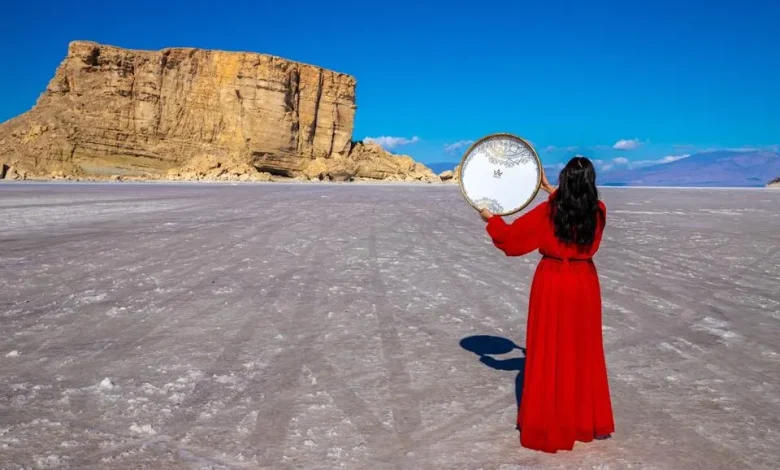
Located between the provinces of East Azerbaijan and West Azerbaijan in Iran, Lake Urmia is a symbol of national pride and is on a list of wetlands of international importance called the Ramsar List. Over decades, excessive water use, dam construction, diversion of rivers, and longer periods of drought have gradually shrunk Lake Urmia into a fraction of what it used to be.
Because of its dry conditions, the lake’s death knell was almost rung last month before nature came to its rescue and gave it some life with precipitation. But the problem is much more serious and long-term to be solved by a few drops of rain here and there, experts say.
“We are witnessing a tragedy take place right before our eyes,” says Kaveh Madani, director of the United Nations University Institute for Water, Environment and Health.
“What is happening to Lake Urmia is the result of water mismanagement in the lake basin and aggressive upstream water withdrawal,” adds Madani. On top of that, climate change and rising temperatures in the region are making everything worse.
Meanwhile, as Lake Urmia remains on life support, environmentalists believe its final fate is yet to be sealed. However, saving it is a complicated task requiring political will from Iran together with an international effort to address some of the fundamental causes leading to the lake’s drastic water decline.
Apple Confirms Impressive MacBook Pro Special Offer
Donald Trump Said He Would Encourage Russians To Do ‘Whatever They Want.’ That Includes Killing Little Girls In Ukraine.
Texas: How, When And Where To See April’s Total Solar Eclipse—Maps, Times And The Best Places
URMIA, IRAN – JULY 06: A drone photo shows that people enjoy at the Lake Urmia, one of the biggest … [+]
ANADOLU AGENCY VIA GETTY IMAGES
Once Upon A Time
At its best, Lake Urmia was among the largest lakes on the planet with its waters providing food, jobs and health benefits for the majority ethnic Azeri and Kurd population living in the northwestern surrounding areas of Iran.
Tourists would travel from near and far to bathe in the lake because of its salinity and potential healing powers. Lake Urmia was also a stop for a range of birds including flamingos, pelicans, egrets, and ducks that visited it during migration seasons.
Not to mention the lake being home to a special kind of shrimp that can, unlike some species, survive in super salty waters.
Today, that’s all a distant recollection and the attributes of the lake can only be seen in history books. According to research, since around the time of the Islamic Revolution in 1979, Lake Urmia has shrunk by 90% in size, a percentage that fluctuates depending on whether the country is in a wet or dry year.
Inefficient agricultural practices, unsustainable development, the depletion of the country’s groundwater, and more heat are some of the factors contributing to Lake Urmia’s downfall.
“We have just choked this lake and we are not letting it be,” says Ali Mirchi, associate professor of water resources at Oklahoma State University.
“If Lake Urmia goes, there’ll be huge implications for public health through respiratory diseases, eye irritation, and other complications,” adds Mirchi.
A big danger is the increasing threat of storms that occur when the water recedes leaving salt particles to be picked up by the wind and flown into people’s lungs. Scientists warn that a dying Lake Urmia could also lead to outcomes including the destruction of local food webs, water conflicts and forced migration of millions.
“Saline lakes have very fragile and unique ecosystems that if they fall apart, the consequences can be global,” says Sarah Null, professor of watershed science at Utah State University.
“Protecting these lakes is important for the environment as well as people,” adds Null.
07/27/2007 Urmia, Iran. four men lie covered in salt and mud on the shore of Lake Urmia, a salt lake … [+]
MIDDLE EAST IMAGES/AFP VIA GETTY IMAGES
Tears For Restoration
Also known as “the turquoise solitaire of Azerbaijan” and part of the fabric of Iran’s culture, losing Lake Urmia has not been an easy possibility for people of the northwest to stomach.
Ethnic groups are regularly organizing campaigns online and on the ground to try and save the lake from dying. “Let us cry so that with our tears we replenish Lake Urmia” is one of the slogans chanted by locals as a sign of frustration towards the Islamic Republic’s failure to preserve the lake.
Back in 2011, demonstrations broke out in cities of Tabriz and Urmia with thousands demanding an end to actions that have drained the county’s water resources. To suppress the crowds, security forces responded with violence, intimidation and mass arrests, Human Rights Watch reported.
Detention of local environmental activists protesting against the drying of Lake Urmia continues until today, reports show.
“Many people have fought for the lake’s restoration over the years, but Iran is water bankrupt, and the problem will keep getting worse if policies remain the same,” says Madani, also a research professor at the City College of New York.
“The lake has unfortunately become a victim of political games, despite sincere efforts made by experts, scientists, and activists to bring it back to life,” adds Madani.
Given its ability to unite people around a single cause, Lake Urmia is both feared and revered by authorities in Iran who have a long history of using it as a bargaining chip.
Notably, Hassan Rouhani who served as president from 2013 to 2021, made promises to voters to revive the lake through a ten-year rehabilitation program costing billions of dollars.
For a while towards the end of Rouhani’s term in office, the lake had a couple of good years, but “that turned out to be more about luck and big precipitation events,” says Mirchi.
Nevertheless, “the administration counted it as a victory,” adds Mirchi.
When hardliner Ebrahim Raisi took over the presidency in 2021, Iranians became even more concerned about the state of the environment under his care.
Three years in, top environmental officials appointed to Raisi’s cabinet haven’t been able to show a good report card regarding Lake Urmia and have often relied on the weather and rain to improve the lake’s water levels.
At times, even members within the system of Iran’s government have spoken out against the current administration’s priorities and inaction towards environmental degradation across the country.
Case in point, Issa Kalantari, a former head of Iran’s Department of Environment and decision-maker in Lake Urmia’s restoration task force, recently told reporters “reviving the lake is the last thing on the minds of the people who are in charge of its revival.”
Iran’s environmental authority did not respond to a request for comment.
11/01/2023 Urmia, Iran. A ship stranded in the growing salt flats of Lake Urmia, a salt lake in the … [+]
MIDDLE EAST IMAGES/AFP VIA GETTY IMAGES
Desperate Measures
According to the Ministry of Energy, roughly 90% of Iran’s water is extracted by the agriculture sector, a problem that many different nations share.
Incidentally, scientists believe inefficient farming practices are among the main reasons why some of the most significant lakes around the world are in trouble.
The Great Salt Lake in Utah, the Caspian Sea in Iran and the Dead Sea in the Middle East are just a few examples. And Lake Urmia is no different, experts say.
“At the basis, it’s an allocation problem. Either you allocate water to the lake, or you let the water be used for farming,” says Jay Lund, professor of civil and environmental engineering and geography at the University of California, Davis.
“We have seen what giving all the water to agriculture does to the lakes, so it would be good to point out all the dangers and arrive at some sort of compromise,” adds Lund.
The destruction of a saline lake be it in the United States, Iran or anywhere else, can lead to the spread of disease, salt storms and loss of biodiversity, potentially costing countries thousands of jobs and billions of dollars annually.
As for the solution to this global challenge, “at the end of the day, it’s all about looking forward to see how we can get more water into the lakes to save them,” says Null.
To free up more water for the lakes, governments are looking into a whole bunch of options. Putting up barriers to make the lakes smaller, buying water from farmers, and leaving alone the rivers that naturally feed the lakes are some of the suggestions being thrown around in scientific circles.
It remains to be seen whether any of these solutions will or can be implemented in Iran and Lake Urmia, but one thing is for certain, experts say.
“The death of the lake would not only be a bitter environmental disaster, but it would also be a public execution of hope,” says Madani.
“The question is, what is it going to take,” he adds.











